

Johns Hopkins University (JHU) continues to pad its space community résumé with their interactive map, “The map of the observable Universe”, that takes viewers on a 13.7-billion-year-old tour of the cosmos from the present to the moments after the Big Bang. While JHU is responsible for creating the site, additional contributions were made by NASA, the European Space Agency, the National Science Foundation, and the Sloan Foundation.
Here's a topic I haven't dared to touch yet! #space #alien #uap Please support my channel! EARLY VIDEO RELEASES, DISCORD MEMBERSHIP AND EXCLUSIVE CONTENT PLUS 15% OFF MERCH! Support / angryastronaut on Patreon please donate via pay pal Follow me on twitter: Follow / astro_angry on X (formerly Twitter) Please support my European Tour! A $10 donation is good for a free digital copy of my book, PLUS a ticket to my upcoming tour!! Team Space media on Twitter: Team Space Media Group / wearetsmg on X (formerly Twitter)

Published on Jun 20, 2013 In this short explainer video, Universe Today publisher investigates the riddle of the Fermi Paradox; if the Universe is big, and old, and there are countless habitable worlds, why do we see no evidence of life? Where are all the aliens?
Published on Jul 15, 2015 SETI researcher Seth Shostak bets that we will find extraterrestrial life in the next twenty-four years, or he'll buy you a cup of coffee. At TEDxSanJoseCA, he explains why new technologies and the laws of probability make the breakthrough so likely and forecasts how the discovery of civilizations far more advanced than ours might affect us here on Earth. (Filmed at TEDxSanJoseCA.) TEDTalks is a daily video podcast of the best talks and performances from the TED Conference, where the world's leading thinkers and doers give the talk of their lives in 18 minutes (or less). Look for talks on Technology, Entertainment and Design -- plus science, business, global issues, the arts and much more. Find closed captions and translated subtitles in many languages Follow TED news on Twitter: Like TED on Facebook Subscribe to our channel Category Science & Technology License Standard YouTube License
NASA AND THE SEARCH FOR TECHNOSIGNATURES A Report from the NASA Technosignatures Workshop(PDF)
Among scientists there is the certainty that life extends throughout the Cosmos. Astrophysicists, geologists, engineers, astrobiologists, and a lot of resources are being utilised in hopes of finding life inside and outside our solar system. Finding it is only a matter of time. The time is approaching, and one day we might say that we are not the only inhabited world. Subscribe to Spark for more amazing science, tech & engineering videos: Join the Spark Channel Membership to get access to perks: / @sparkdocs Do you love uncovering the past, exploring historic sites, and venturing to distant lands? Join History Hit today and stream hundreds of exclusive documentaries, with new releases every week. Plus, enjoy ad-free access to our podcast network for even more history every week. Head over to to secure your free trial, and embark on your journey through history! Any queries, please contact us at: (E-mail) #Spark

mage: This is Figure 1 from the paper. Caption: A cartoon of the three directions of target selection and the relative advantages of Breakthrough Listen’s primary programs observing stars and galaxies (green), a survey of the Breakthrough Listen Exotica Catalog (blue), and some example campaigns. Previous SETI surveys have generally aimed for depth, achieving strong limits for a small number of similar targets, or high-count, achieving modest limits for a large number of similar targets. Other exotica efforts can be high-depth (red) or high-count (gold) campaigns, but observations of the Exotica Catalog will be broad, achieving modest limits on a small number each of a wide variety of targets. Future discoveries may be added to a later version of the catalog (pale blue), or prompt new campaigns that we cannot yet plan for (grey). Credit: Lacki et al.

The nearby triple star system Gliese 667, taken on June 29, 2013. Credit and copyright: Efrain Morales, Jaicoa Observatory, Puerto Rico. Here is a great new observation of the triple star system Gliese 667 from astrophotographer Efrain Morales of the Jaicoa Observatory in Puerto Rico. Recently, one of the stars, 667 C was found to have perhaps seven planets orbiting it! If all seven planets are confirmed, the system would consist of three habitable-zone super-Earths, two hot planets further in, and two cooler planets further out. Scientists say that the ?f? planet is ?a prime candidate for habitability.?


A new study has offered a new take on the Fermi Paradox - alien civilizations are not visible
to us because they are sleeping. Credit and Copyright: Kevin M. Gill
Published on Jun 20, 2013 In this short explainer video, Universe Today publisher investigates the riddle of the Fermi Paradox; if the Universe is big, and old, and there are countless habitable worlds, why do we see no evidence of life? Where are all the aliens?


Published on Sep 19, 2013 A Dyson Sphere is a megastructure that could be built around a star to harness all the solar energy it gives off. In this video we talk about the different kinds of Dyson Spheres, Dyson Clouds and other megastructures that could be built - and how we might even detect them from Earth.
If we are to believe the Russian scientist Nikolai Kardashov, there are countless civilizations in the universe that are far more intelligent than we are! Scientists have just discovered 7 stars that show signs of the influence of such extremely advanced extraterrestrial civilizations. It is possible that beings we can hardly imagine have built power plants around these stars and we are witnessing the aliens sucking the energy out of the stars.
Published on Aug 25, 2014 One answer to the Fermi Paradox is the idea of the Great Filter; the possibility that something wipes out 100% of intelligent civilizations. That's why we've never discovered any aliens... they're all dead. Is that our future too?

A lecture given by SETI scientist, Dr. Jill Tarter at the Paramount Theater in Charlottesville, Virginia on Monday night October 27th saw some uncomfortable moments when an audience member confronted the celebrated astronomer with notions that the organization was involved in a cover-up of what he thought was the reality of an extraterrestrial presence on planet Earth. SETI is an acronym for a group of radio astronomers meaning: The Search for Extra Terrestrial Intelligence.

This artist concept illustrates how two large, planet-sized objects could collide to create clumps of material in orbit around a star. They'd also create a lot of dust, which would glow in infrared light, something not seen around the Kepler star. Credit: NASA/JPL-Caltech/T. Pyle (SSC)

The challenge is as follows: This is a call for a fun scientific challenge. Suppose a telescope on Earth receives a series of pulses from a fixed, unresolved source beyond the solar system. The source is a star about 50 light years from Earth. The pulses are in the form of short/long signals and they are received in a very narrow band around an electromagnetic frequency of 452.12919 MHz. A computer algorithm identifies the artificial nature of the pulses. It turns out the pulses carry a message. The pulses signify binary digits. Suppose further that you were, by whatsoever reason, put in charge of decoding this message. If you successfully decrypted the message, you should be able to answer the following questions: 1. What is the typical body height of our interstellar counterparts? 2. What is their typical lifetime? 3. What is the scale of the devices they used to submit their message? 4. Since when have they been communicating interstellar? 5. What kind of object do they live on? 6. How old is their stellar system? The competition closes on 3 June, 2016 .

A study using data from NASA's Chandra X-ray Observatory and ESA's XMM-Newton suggests X-rays emitted by a planet's host star may provide critical clues to how hospitable a star system could be. Credit: NASA/CXC/M.Weiss

Scientists are using X-rays to determine the hospitability of stars for life on exoplanets. Data from NASA's Chandra X-ray Observatory and ESA's XMM-Newton were used to study 24 stars like our Sun that were at least one billion years old. They found these older stars had lower levels of X-rays and hence magnetic activity than other types of stars. This relatively calm is good news for life trying to form on planets around these stars. Astronomers will continue to look at different properties, including X-rays, to assess the best place to look for life outside our Solar System. Category Science & Technology License Standard YouTube License




Humans are believed to be the most technologically advanced civilization that’s ever set foot on Earth, or really anywhere in the Solar System. But are we the first? Could there have been an advanced civilization that walked the Earth millions or even billions of years ago, and then died out long ago, their technology and structures lost to the eons. And how could we know? Audio Podcast version: ITunes: RSS: Video Podcast version: ITunes: RSS: What is Fraser's Watching Playlist: Sign up to my weekly email newsletter: Support us at:Support us at: : More stories at Follow us on Twitter: @universetoday Like us on Facebook: Google+ - Instagram - Team: Fraser Cain - @fcain / frasercain@gmail.com /Karla Thompson - @karlaii Chad Weber - Chloe Cain - Instagram: @chloegwen2001

Sign up to my weekly email newsletter: Support us at:Support us at: : More stories at Follow us on Twitter: @universetoday Like us on Facebook: Google+ - Instagram - Team: Fraser Cain - @fcain / frasercain@gmail.com /Karla Thompson - @karlaii Chad Weber - Chloe Cain - Instagram: @chloegwen2001 Team: Fraser Cain - @fcain Jason Harmer - @jasoncharmer Susie Murph - @susiemmurph Brian Koberlein - @briankoberlein Chad Weber - weber.chad@gmail.com Kevin Gill - @kevinmgill Created by: Fraser Cain and Jason Harmer Edited by: Chad Weber Music: Left Spine Down - “X-Ray”

Illustration showing the Lamba Cold Dark Matter (LCDM) model, which indicates how the influence of dark energy has led to an accelerated rate of cosmic expansion. Credit: Wikipedia Commons/Alex Mittelmann
Sign up to my weekly email newsletter: Support us at:Support us at: : More stories at Follow us on Twitter: @universetoday Like us on Facebook: Google+ - Instagram - Team: Fraser Cain - @fcain / frasercain@gmail.com /Karla Thompson - @karlaii Chad Weber - Chloe Cain - Instagram: @chloegwen2001 Team: Fraser Cain - @fcain Jason Harmer - @jasoncharmer Susie Murph - @susiemmurph Brian Koberlein - @briankoberlein Chad Weber - weber.chad@gmail.com Kevin Gill - @kevinmgill Created by: Fraser Cain and Jason Harmer Edited by: Chad Weber Music: Left Spine Down - “X-Ray”
SEARCHING FOR EXTRATERRESTRIAL CIVILIZATIONS USING A GAMMA RAY TELESCOPES
Detcting Exo Clarke- belts (PDF)
SETI@home: New paper on observing "Clarke Exo-belts" Dr. Korpela and his colleagues Prof. Shauna Sallmen and Ms. Kaisa Crawford-Taylor have published a new paper today in the Astronomical Journal about whether astronomers be able to detect belts of satellites circling planets around other stars. Unfortunately, the answer is that even the thickest satellite belts will be very difficult to see with current technology. Even the James Webb Space Telescope will find it difficult.
May 12, 2022 Are these Lurkers? Researcher Beatriz Villarroel found bright, shiny, possibly flat or complex shaped objects that were in geo-synchronous orbit with Earth in the early 50's. Well before Sputnik or any other attempted satellites. Also, three of the objects travel in a straight line. We live in a world where we are constantly observing ourselves from orbit. We don’t even think twice about the satellite surveillance of our world because it’s us doing it. But imagine if we were being watched by someone else, far before the dawn of the space age by some unknown agent. More, think of a scenario where it was watching us, and we were inadvertently with our astronomical photographic plates watching it as well. In 1957 the Soviet Union launched humanity’s first orbital satellite, Sputnik 1 ushering in the age of telecommunications and satellites of all flavors from weather to espionage. But our ability to monitor the skies photographically stretches decades before the advent of human space travel, leaving us with an enormous collection of astronomical survey plates to study. Within these plates, previous to 1957, you shouldn’t expect to find anything transient presenting itself as a satellite since we didn’t have them yet. But that’s apparently not the case. In a photographic plate dating from 1950 my guest today has identified a transient phenomenon that not only appears like a satellite would, but actually tracks across the plate exactly as you would expect a satellite in orbit of earth would do. Now there have been conspiracy theories floating around on the internet such as the Black Knight regarding satellites previous to the space age, but these are urban legends that conflate different sources, usually coupled with a photograph of a very human made thermal blanket in orbit. But there is a kernel of something here, there was one such mention of the possibility of artificial satellites of unknown origin before the space age began was made by Major Donald Keyhoe, a prominent figure in the early days of UFOlogy, reporting that the US government was aware of two such satellites. If there was any truth to that report is unknown, but it’s interesting nonetheless. Adding to this mystery, there are other obscure oddities hidden within the history of science that may deepen this mystery. One of these are the mysterious signals Nikola Tesla reported picking up that he thought were of alien origin, though in reality it could just as easily been pulsars or any of the other myriad of natural radio sources that were unknown in his day. But there are also the case of Long Delayed Echoes in radio, where transmissions repeat back to the transmitter often seconds afterward as an echo. Echoes in Radio are not uncommon, the ionosphere loves doing things like that, but a delay of seconds raises eyebrows. Does something repeat or reflect our signals back to us occasionally? But setting that aside, astronomers looking for transients in photographic plates and then have it result in a detection is in itself astonishing. They simply should not be there, and in 1950 no one on earth was anywhere close to the capability of putting a satellite in orbit. And it’s not just one candidate, but three, that really do appear to line up in a non-random way and not as a result of a defect in the plate, though this still needs to be confirmed. Whatever these objects were is a complete unknown. So the question is open, were we being watched? If you would like to help fund the work Beatriz and her team are doing, please contact them directly. beatriz.villarroel(@)su.se Is there a background population of high-albedo objects in geosynchronous orbits around Earth? Exploring nine simultaneously occurring transients on April 12th 1950 00:00:00 Intro 00:03:33 Bio 00:04:00 Transient Artifacts? 00:06:55 What was found 00:08:55 geosynchronous orbit? 00:12:48 Citizen science projects 00:14:00 Possible shapes? 00:19:28 Looking for other objects 00:24:52 Nuclear tests? Youtube Membership Podcast: Apple: More JMG his youtube chnnel Patreon Page for Event Horizon Follow us at other places! @JMGEventHorizon Music: Stellardrone Bandcamp Miquel Johnson Bandcamp FOOTAGE: NASA ESO/Hubble ESO - M.Kornmesser Pixabay #uap #fermiparadox
Solution to the Fermi Paradox Found! Scientists Hope They're Wrong ► Subscribe: If we consider our solar system is typical of billions and billions of other similar systems, then where are the extraterrestrials? The universe should be full of intelligent life by now that would create some kind of signal that is easy to detect…yet, we have seen and heard nothing. There is one possible solution to the unnerving silence of the cosmos, and it could be the most chilling answer to why we’ve heard from no one…because if an alien civilization does exist out there somewhere, they certainly know we are here…and that is something that should scare all of us. We are on social media: Facebook / destinymediaa The Destiny voice:
Explore the possibility that higher alien civilizations are watching us in this mind-blowing video. Are we truly alone in the universe? Dive into the fascinating theory! #orbit #aliens #orbitaliens #alien #orbitspace #ufosightings nasa reveals,ufo,ufos,ufo sighting,ufo sightings,so many ufo sightings,ufo caught on camera,ufo video,ufo spotted,ufo videos,ufo footage,ufo video clips,aliens,proof of aliens,aliens video,unbelievable facts,orbit ,orbit ufo,orbit aliens,alien sighting,ancient aliens,alien spotted,aliens are real,real alien spotted,lab 360, lab360,lab 360 ufo,Space,higher alien civilization are watching us Welcome to ORBIT BEYOND THE BLUE – Your Gateway to the SECRETS OF UNIVERSE! 🚀 About Us 🛸 At Orbit, we embark on an extraordinary journey into the vast and mysterious realms of space, aliens, and the unexplained. Our mission is to ignite your curiosity, expand your knowledge, and fuel your imagination as we navigate the cosmic wonders that surround us. 🔥 TRENDING NOW on Orbit: • TRENDING NOW ON ORBIT - BEYOND THE BLUE 👽 Alien and UFO Sightings: • Alien, UFO / UAP Sightings 🛰️ James Webb Space Telescope: • James Webb Space Telescope: Discoveries 🤯 Mysteries And Unexplained Phenomena: • Mysteries And Unexplained Phenomena 🔭 Space Explorers - Stay updated on the latest discoveries and breakthroughs shining from the depths of space. Subscribe now for a cosmic journey! 🌌✨

During the 1940s, Hungarian-American scientist John von Neumann developed a mathematical theory for how machines could endlessly reproduce themselves. This work gave rise to the idea of “von Neumann probes“, a class of self-replicating interstellar probes (SRPs) that could be used to do everything from exploring the Universe to seeding it with life and intervening in species evolution.
As you know, I’m obsessed about the Fermi Paradox. Where are all the aliens? But an even stranger question is: where are all the robot aliens? Sign up to my weekly email newsletter: Support us at:Support us at: : More stories at Follow us on Twitter: @universetoday Like us on Facebook: Instagram - Team: Fraser Cain - @fcain / frasercain@gmail.com /Karla Thompson - @karlaii Chad Weber - Chloe Cain - Instagram: @chloegwen2001 Music: Left Spine Down - “X-Ray”
We often think of colonizing or even terraforming a planet, but how about colonizing every planet in your galaxy, and not by spaceships but by self replicating machines. In this episode, we will be looking at von Neumann probes, discussing many reasons why you’d use them, tied in with the Fermi paradox. ►Click here to subscribe: to astro focus ►Written, Produced & Narrated by: David ►Share this video: https://youtu.be/SEziF9P8ZZc Music: “Cylinder Five” by Chris Zabriskie “A Memory of Earth” by Markus Junnikkala
In this short video explainer, Universe Today publisher Fraser Cain investigates the search for extraterrestrial intelligence (SETI). How could we find and communicate with other civilizations?

NASA’s Wide Field Infrared Survey Telescope (WFIRST) will capture Hubble-quality images covering swaths of sky 100 times larger than Hubble does. Credits: NASA/GSFC/Conceptual Image Lab
View full lesson: Could human civilization eventually spread across the whole Milky Way galaxy? Could we move beyond our small, blue planet to establish colonies in the multitude of star systems out there? These questions are pretty daunting, but their (theoretical) answers were actually put forth decades ago. Roey Tzezana describes the conceptual von Neumann machine. Lesson by Roey Tzezana, animation by Eoin Duffy. Category

It’s been seventy years (as of 11-21) since physicist Enrico Fermi asked his famous question: “Where is everybody?” And yet, the tyranny of the Fermi Paradox is still with us and will continue to be until definitive evidence of Extraterrestrial Intelligence (ETI) is found. In the meantime, scientists are forced to speculate as to why we haven’t found any yet and (more importantly) what we should be looking for. By focusing our search efforts, it is hoped that we may finally determine that we are not alone in the Universe.

This illustration shows how gravitational lensing works. The gravity of a large galaxy cluster is so strong, it bends, brightens, and distorts the light of distant galaxies behind it. Credit: NASA/ESA/L. Calcada
As you know, I’m obsessed about the Fermi Paradox. Where are all the aliens? But an even stranger question is: where are all the robot aliens? Sign up to my weekly email newsletter: Support us at:Support us at: : More stories at Follow us on Twitter: @universetoday Like us on Facebook: Instagram - Team: Fraser Cain - @fcain / frasercain@gmail.com /Karla Thompson - @karlaii Chad Weber - Chloe Cain - Instagram: @chloegwen2001 Music: Left Spine Down - “X-Ray”

Planets everywhere. So where are all the aliens? Credit: ESO/M. Kornmesser

From top to bottom: The plentiful M dwarfs or red dwarfs; the less plentiful K dwarfs; the relatively uncommon G-type star, like our Sun. The graphic compares the stars in terms of several important variables. The habitable zones, potentially capable of hosting life-bearing planets, are wider for hotter stars. The longevity for red dwarf M stars can exceed 100 billion years. K dwarf ages can range from 15 to 45 billion years. And, our Sun only lasts for 10 billion years. The relative amount of harmful radiation (to life as we know it) that stars emit can be 80 to 500 times more intense for M dwarfs relative to our Sun, but only 5 to 25 times more intense for the orange K dwarfs. Red dwarfs make up the bulk of the Milky Way’s population, about 73%. Sunlike stars are merely 6% of the population, and K dwarfs are at 13%. When these four variables are balanced, the most suitable stars for potentially hosting advanced life forms are K dwarfs. Credits: NASA, ESA and Z. Levy (STScI)
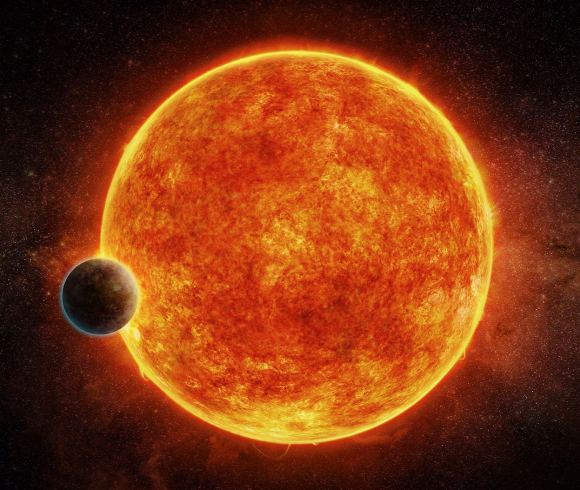
Tidally-locked exoplanets may be very common around red dwarf (M-dwarf) stars because of their close orbits. Image Credit: M. Weiss/CfA
AD | To try everything Brilliant has to offer for free for a full 30 days, visit and you'll also get 20% off an annual premium subscription. | Back in 2023, we saw the first ever claim that JWST had discovered a possible signature of life in the atmosphere of an exoplanet, a planet orbiting another star in our galaxy the Milky Way. But the evidence for the claim that dimethyl sulphide exists in K2-18b’s atmosphere was weak. Now, in the past few months of 2024, we’ve had two new papers analysing the data from K2-18b which both claim there are other models that can explain K2-18b just as well, with the same level of statistical backing. So what is going on here? So let's dive into what’s going on so you can all make up your own mind. Madhusudhan et al. (2023; hycean world with DMS evidence) - Shorttle et al. (2024; hydrogen atmosphere with magma ocean) - Wogan et al. (2024; mini-Neptune) Hu et al. (2021; prediction of the molecules present in a hycean world atmosphere) - Benneke et al. (2019; water vapour in K2-18b's atmosphere) - Cloutier et al. (2019; K2-18b mass) - Foreman-Mackey et al. (2015; K2-18b discovered in K2 data) - Seager et al. (2013; biosignatures in hydrogen atmospheres) - JWST proposal 2722 (PDF) JWST proposal 2372 - (PDF) 00:00 - Introduction 02:45 - What do we know about K2-18b so far? 05:21 - Madhusudhan et al. (2023) - K2-18b is a hydrogen atmosphere with a liquid water ocean with dimethyl sulphide 09:33 - Shorttle et al. (2024) - K2-18b has hydrogen atmosphere with a magma ocean 11:05 - Wogan et al. (2024) - K2-18b is just a mini-Neptune 13:19 - What data do we need to figure this out? 16:37 - Bloopers My previous video on K2-18b: Did JWST find a MARKER OF LIFE in an exoplanet atmosphere? My previous video on the markers for life JWST is looking for: • JWST is hunting for these FOUR signs of alien life - WHERE, WHEN & HOW will we find it?! Video filmed on a Sony ⍺7 IV 🎧 Royal Astronomical Society Podcast that I co-host: 📚 My new book, "A Brief History of Black Holes", out NOW in paperback, e-book and audiobook (which I narrated myself!): 📚 "The Year In Space" celebrating all things space in 2022 from me and the rest of the Supermassive Podcast team: 👕 My new merch, including JWST designs, are available here (with worldwide shipping!): 🔔 Don't forget to subscribe and click the little bell icon to be notified when I post a new video! I'm Dr. Becky Smethurst, an astrophysicist at the University of Oxford (Christ Church). I love making videos about science with an unnatural level of enthusiasm. I like to focus on how we know things, not just what we know. And especially, the things we still don't know. If you've ever wondered about something in space and couldn't find an answer online - you can ask me! My day job is to do research into how supermassive black holes can affect the galaxies that they live in. In particular, I look at whether the energy output from the disk of material orbiting around a growing supermassive black hole can stop a galaxy from forming stars. DR. BECKY SMETHURST ASTROPHYSICIST. SCIENCE COMMUNICATOR. AUTHOR. DR. BECKY SMETHURST ASTROPHYSICIST. SCIENCE COMMUNICATOR. AUTHOR.

This is an artist’s impression of the well-known TRAPPIST-1 system, a red dwarf that hosts 7 exoplanets. Thought the planets are all terrestrial planets, and three of them are in the habitable zone, the observed flaring from the TRAPPIST-1 star means life is unlikely. Image Credit: NASA/JPL-Caltech
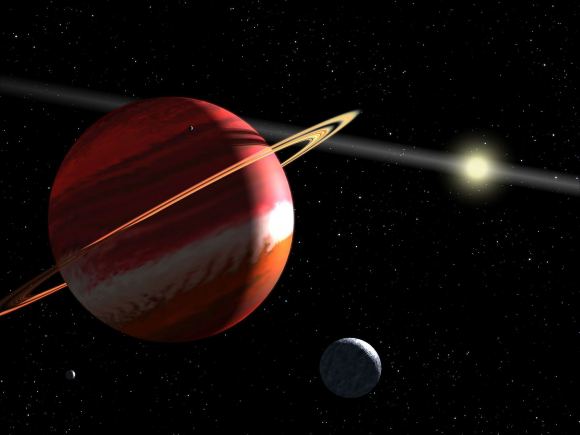
An artist’s illustration of Epsilon Eridani and two exoplanets. EE is a K-dwarf star that’s only 10.5 light years from the Sun. It may host exoplanets, but their existence is controversial. Epsilon Eridani is young, only a billion years old, and it’s undergoing a tumultuous youth at this age. But it’ll calm down eventually, and could be a stable, hospitable star for tens of billions of years. Image Credit : By NASA, ESA, G. Bacon – Public Domain,from Wikipedia
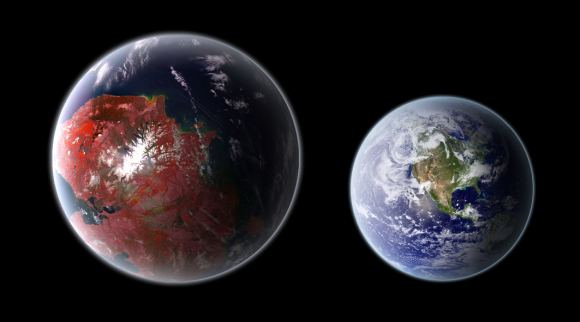
Kepler 442 is a K-dwarf star hosting a rocky exoplanet about twice as massive as Earth. The planet is in the star’s habitable zone and is an object of intense interest. Artist’s illustration. Image Credit: By Ph03nix1986 – Own work, CC BY-SA 4.0,
Effects of M dwarf magnetic fields on potentially habitable planets (PDF)



What's this? this is the original speculative message sent out in November 1974 and the response(?) found as a crop glyph in southern England.

The Arecibo Message is Answered by Aliens in a Mind Blowing Crop Circle! The Arecibo message was beamed into space a single time (not repeated) via frequency modulated radio waves at a ceremony to mark the remodeling of the Arecibo radio telescope on 16 November 1974.

On November 16th, 1974, a coded radio message was broadcast from the Arecibo Observatory in Puerto Rico. The message contained information on mathematics, humanity, the Solar System, DNA, and the Observatory itself. The destination for this message was Messier 13 (NGC 6205 or “The Great Hercules Cluster”), a globular star cluster located about 25,000 light-years from Earth in the constellation of Hercules.
In this short explainer video, Universe Today publisher investigates the riddle of the Fermi Paradox; if the Universe is big, and old, and there are countless habitable worlds, why do we see no evidence of life? Where are all the aliens?

Frank Drake and the Drake Equation. Credit: SETI Institute
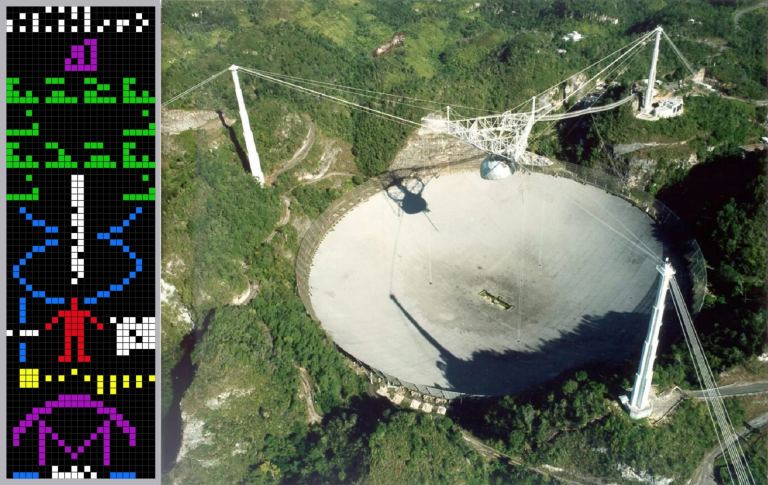
The Arecibo radio telescope in Puerto Rico and the Arecibo Message (inset). Credit: Seth Shostak/SETI Institute/AP
In this short video explainer, Universe Today publisher Fraser Cain investigates the search for extraterrestrial intelligence (SETI). How could we find and communicate with other civilizations?

Should we be listening or broadcasting in the search for ETI? Credit: UCLA SETI Group/Yuri Beletsky, Carnegie Las Campanas Observatory
Get MagellanTV here: and get an exclusive offer for our viewers: an extended, month-long trial, FREE. MagellanTV has the largest and best collection of Science content anywhere, including Space, Physics, Technology, Nature, Mind and Body, and a growing collection of 4K. This new streaming service has 3,000+ great documentaries. Check out our personal recommendation and MagellanTV’s exclusive playlists: ?? Subscribe for more: ?? Share this video with a fellow space traveler: ?? Watch my most recent upload: ?? Help me improve the channel by joining the community on Patreon ?? Check out Launch Pad merchandise! In 1974, the Arecibo radio telescope transmitted a message to contact extraterrestrials. The message was designed by Frank Drake. Here's what it says. 00:00 Start 01:40 Magellan TV 02:35 History of the message and M13 04:35 How the message was sent 05:26 Message Structure 06:30 Decoding the first 10 numbers from binary 08:20 Atomic elements and DNA 09:41 Depiction of humanity and population 10:51 Depiction of Arecibo 11:36 Testing the message and dangers 14:00 We're disappearing 15:19 Possible signal detected? : 🔔 Subscribe for more 🖖 Share this video with a fellow space traveler: 🔴 Watch my most recent upload: 🚀 Help me improve the channel by joining the community on Patreon ?? Check out Launch Pad merchandise! Disclaimer: Some of these links go to one of my websites and some are affiliate links where I'll earn a small commission if you make a purchase at no additional cost to you. 🧭 Reference: Encyclopedia Galactica (Write Science): ? Let's connect: For business inquiries - chris AT christianready DOT com Twitter - @launchpadastro Instagram - @launchpadastro - Facebook Discord - ?? c/o Christian Ready P.O. Box 66 Westminster, MD 21158 United States Earth
P>
Institute – Arecibo Message Astronomy and Ionosphere Center – The NEW Arecibo Message Staff. “The Arecibo Message of November 1974.” Icarus, vol. 26, no. 4 (1975) News – “It’s the 25th anniversary of Earth’s first (and only) attempt to phone E.T.” (Nov. 12, 1999)
Good telescope that I've used to learn the basics: Get a Wonderful Person shirt: Alternatively, PayPal donations can be sent here: Hello and welcome! My name is Anton and in this video, we will talk about a new version of iconic #arecibo message that may be sent to extraterrestrial intelligence in the near future Links: A Beacon in the Galaxy: Updated Arecibo Message for Potential FAST and SETI Projects List of interstellar radio messages Arecibo message Alien e-mail reply to arrive in 2015? RuBisCo Stars and the Riddle of Life METI (Messaging Extraterrestrial Intelligence Cosmic Call This SETI Message to a Nearby Star Will Arrive in 2022 #seti #meti Support this channel on Patreon to help me make this a full time job: Space Engine is available for free here: Enjoy and please subscribe. Or get a shirt: Twitter: Facebook: Twitch: Bitcoins to spare? Donate them here to help this channel grow! 1GFiTKxWyEjAjZv4vsNtWTUmL53HgXBuvu The hardware used to record these videos: CPU: Video Card: Motherboard: RAM: PSU: Case: Microphone: Mixer: Recording and Editing: Some of the above are affiliate links, meaning I would get a (very small) percentage of the price paid. Thank you to all Patreon supporters of this channel Special thanks also goes to all the wonderful supporters of the channel through YouTube Memberships. Images/Videos: Hisashi Hirabayashi Sid Leach/Adam Block/Mount Lemmon SkyCenter CC BY-SA 4.0 3.0 Colby Gutierrez-Kraybill -CC BY Licenses used: Licenses by 4.0 hLicenses by-sa 4.0 Licenses by 3.0 Licenses by-sa 3.0 Licenses by 2.5 Licenses by-sa 2.5 Licenses by 2.0 Licenses by-sa 2.0 Music in this video Learn more Listen ad-free with YouTube Premium Song After All Artist Geographer Album After All Licensed to YouTube by YouTube Audio Library, and 1 Music Rights Societies Song Birds Artist Silent Partner Album Birds Licensed to YouTube by YouTube Audio Library

The Arecibo radio telescope in Puerto Rico. (Seth Shostak/SETI Institute/Associated Press)

Published on Jun 20, 2013 In this short explainer video, Universe Today publisher investigates the riddle of the Fermi Paradox; if the Universe is big, and old, and there are countless habitable worlds, why do we see no evidence of life? Where are all the aliens?
Get MagellanTV here: and get an exclusive offer for our viewers: an extended, month-long trial, FREE. MagellanTV has the largest and best collection of Science content anywhere, including Space, Physics, Technology, Nature, Mind and Body, and a growing collection of 4K. This new streaming service has 3,000+ great documentaries. Check out our personal recommendation and MagellanTV’s exclusive playlists: ?? Subscribe for more: ?? Share this video with a fellow space traveler: ?? Watch my most recent upload: ?? Help me improve the channel by joining the community on Patreon ?? Check out Launch Pad merchandise! In 1974, the Arecibo radio telescope transmitted a message to contact extraterrestrials. The message was designed by Frank Drake. Here's what it says. 00:00 Start 01:40 Magellan TV 02:35 History of the message and M13 04:35 How the message was sent 05:26 Message Structure 06:30 Decoding the first 10 numbers from binary 08:20 Atomic elements and DNA 09:41 Depiction of humanity and population 10:51 Depiction of Arecibo 11:36 Testing the message and dangers 14:00 We're disappearing 15:19 Possible signal detected? : 🔔 Subscribe for more 🖖 Share this video with a fellow space traveler: 🔴 Watch my most recent upload: 🚀 Help me improve the channel by joining the community on Patreon ?? Check out Launch Pad merchandise! Disclaimer: Some of these links go to one of my websites and some are affiliate links where I'll earn a small commission if you make a purchase at no additional cost to you. 🧭 Reference: Encyclopedia Galactica (Write Science): ? Let's connect: For business inquiries - chris AT christianready DOT com Twitter - @launchpadastro Instagram - @launchpadastro - Facebook Discord - ?? c/o Christian Ready P.O. Box 66 Westminster, MD 21158 United States Earth
P>
Institute – Arecibo Message Astronomy and Ionosphere Center – The NEW Arecibo Message Staff. “The Arecibo Message of November 1974.” Icarus, vol. 26, no. 4 (1975) News – “It’s the 25th anniversary of Earth’s first (and only) attempt to phone E.T.” (Nov. 12, 1999)
The Arecibo Message, beamed out in 1974, and the mysterious Wow! Signal, captured by Ohio State’s Big Ear telescope in 1977, are two iconic instances of interstellar communication. Using OpenSpace, we’re diving into these events and exploring the broader mysteries of sharing intelligence beyond Earth. Open Space: : More information:

Aerial view of the damage to the Arecibo Observatory following the collapse of the telescope platform on December 1st, 2020. Photo courtesy of Deborah Martorell.

The field of extrasolar planet studies is undergoing a seismic shift. To date, 4,940 exoplanets have been confirmed in 3,711 planetary systems, with another 8,709 candidates awaiting confirmation. With so many planets available for study and improvements in telescope sensitivity and data analysis, the focus is transitioning from discovery to characterization. Instead of simply looking for more planets, astrobiologists will examine “potentially-habitable” worlds for potential “biosignatures.”

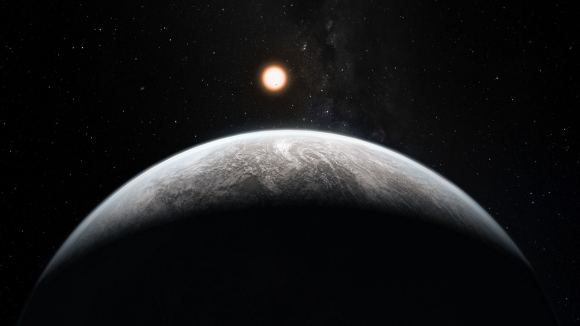
This artist’s impression shows the planet orbiting the Sun-like star HD 85512 in the southern constellation of Vela (The Sail). Credit: ESO

An artist’s illustration of the exoplanet HR8799e, which was directly imaged using the GRAVITY instrument on the ESO’s Very Large Telescope Interferometer. Credit: ESO/L. Calçada

An artist’s illustration of the exoplanet HR8799e directly images by the ESO’s GRAVITY instrument on its Very Large Telescope Interferometer. Credit: ESO/L. Calçada

Artist’s impression of the Nancy Grace Roman space telescope (formerly WFIRST). Credit: NASA/GSFC

For over sixty years, scientists have been searching the cosmos for possible signs of radio transmission that would indicate the existence of extraterrestrial intelligence (ETI). In that time, the technology and methods have matured considerably, but the greatest challenges remain. In addition to having never detected a radio signal of extraterrestrial origin, there is a wide range of possible forms that such a broadcast could take.

The 85-foot (26 m) Howard E. Tatel Radio Telescope at NRAO used in Project Ozma. Credit: Z22/Wikipedia Commons

Radio spectrogram plots created from Setigen frames. Credit: Brzycki et al.
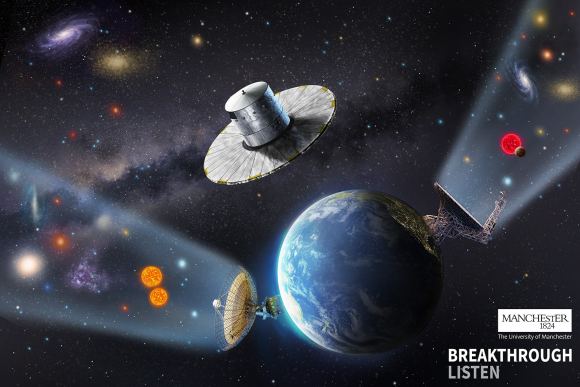
Artist’s impression of Breakthrough Listen and the instruments it relies on. Credit: Breakthrough Listen/Univ. of Machester/Daniëlle Futselaar

Composite image of the SKA combining all elements in South Africa and Australia. Credit: SKAO

One of the 42 dishes in the Allen Telescope Array that searches for signals from space. Credit: Seth Shostak / SETI Institute.

On February 14th, 2020, the SETI Insitute and the National Radio Astronomy Observatory (NRAO) announced a new partnership, which they appropriately named the Commensal Open-Source Multimode Interferometer Cluster Search for Extraterrestrial Intelligence (COSMIC SETI). This partnership will allow the Karl G. Jansky Very Large Array (VLA) to participate in the Search for Extraterrestrial Intelligence (SETI) for the first time in its history.

The end results of the EDFA/Cosmic fiber work. Credit: SETI Institute

SETI Institute Post-Doctoral Researchers, Dr. Savin Varghese, and Dr. Chenoa Tremblay, in front of one of the 82-foot diameter dishes that make up the Very Large Array. Credit: SETI Institute

How will humanity meet its end? That’s only a depressing question if you think that humanity will go on forever. Alas, nothing lasts forever, and if something could last forever, it probably wouldn’t be our struggling primate species. But we’ll likely be around for a while yet, pondering things as we do. One of the things we love to ponder is: why don’t we hear from any other alien civilizations?

Our cities are becoming larger and more interconnected. How far will that trend go? Lights from the United States glow in this night image based on data taken from the Suomi NPP satellite in April and October 2012. Credit: NASA Earth Observatory/NOAA NGDC
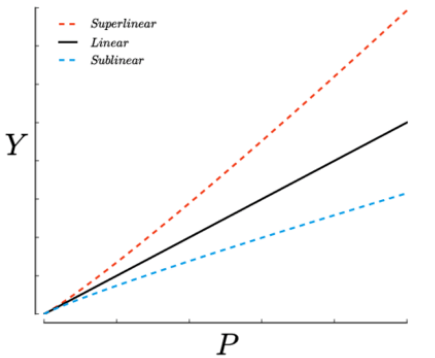
This graph shows the difference between linear, sublinear, and superlinear. Image Credit: Remi Louf, 2015.

This graph from the study shows how population growth leads to singularities that must be avoided by resets or innovations. Image Credit: Bettencourt et al.

This figure from the study shows three different scenarios for a civilization on an asymptotic burnout trajectory. The top civilization reaches burnout without realizing it in advance. The middle civilization sees burnout coming but is unable to reach homeostasis before burning out. The bottom civilization sees burnout coming and successfully reorients itself toward homeostasis. Image Credit: Wong and Bartlett 2022

This figure from the study shows that Type III civilizations may be out of reach and that civilizations are bounded by collapse and homeostasis. Image Credit: Wong and Bartlett 2022.

This figure from the study shows that homeostatic civilizations will last much longer than others. But it’s impossible to know how many, if any, might make it to that point. Image Credit: Wong and Bartlett 202

Humanity’s future is up in the air. Will our distant descendants have the wisdom to see singularities coming? Can we create a global political system to deal with singularities effectively? Who knows. But there’s a melancholy aspect to both asymptotic burnout and homeostatic awakening. In both cases, we’ll never meet the neighbours.

Researchers at Penn State University have studied a new technique that could use a star’s ability to focus and magnify communications which could be passing through our own solar system, and has been accepted for publication in The Astronomical Journal and was part of a graduate course at Penn State covering the Search for Extraterrestrial Intelligence (SETI) The study describes our Sun as potentially acting as a kind of node as part of an interstellar communication network involving probes or relays near our Sun, acting like cellular telephone towers in space.

The Wow! signal represented as “6EQUJ5”. The original printout with Ehman’s handwritten exclamation is preserved by Ohio History Connection. It was pointed towards the Proxima Centauri system. The signal was used to support the search for extraterrestrial intelligence. (Credit: Big Ear Radio Observatory and North American AstroPhysical Observatory (NAAPO))

The Wow! signal represented as 6EQUJ5.
Credit: Big Ear Radio Observatory/NAAPO

Rhodopsins are ancient proteins evolved by some of Earth's first life forms. They turned sunlight into energy without photosynthesis. Image Credit: Sohail Wasif/University of California, Riverside.

Rhodopsins are present in the human eye’s rods, where they work in low light conditions. Image Credit: Arizona State University.
This figure from the paper illustrates the coupling between surface irradiance, spectral tuning, and functional diversity over microbial rhodopsin evolution. (b) is particularly interesting because it shows how the colour tuning of extant and ancestral microbial rhodopsins appear to explore the spectral window not already occupied by other biological pigments such as chlorophylls and bacteriochlorophylls, shown in gray. Image Credit: Sephus et al. 2022.

This figure from the paper illustrates the coupling between surface irradiance, spectral tuning, and functional diversity over microbial rhodopsin evolution. (b) is particularly interesting because it shows how the colour tuning of extant and ancestral microbial rhodopsins appear to explore the spectral window not already occupied by other biological pigments such as chlorophylls and bacteriochlorophylls, shown in gray. Image Credit: Sephus et al. 2022.

Significant gaps exist in our understanding of early Earth’s atmosphere because geologic evidence isn’t complete. This image is from a separate study and shows four sources and sinks for key molecular species in Earth’s early atmosphere. By combining the new evolutionary knowledge of rhodopsins with our models of early Earth, we can better understand what primitive life might look like on other worlds and what those atmospheres might look like. Image Credit: Pearce et al. 2022.

Earth’s most ancient rock holds our best geologic clues about Earth’s early life, but they’re not easy to find and untangle. This image shows Australia’s Jack Hills formation, where ancient zircons hold important clues about the history of life. By Robert Simmon, NASA – Public Domain (Wikipedia)

The James Webb Space Telescope will examine exoplanet atmospheres spectroscopically to identify different molecular species. But studies like this one help us understand what we’re seeing and what to look for. This image is a transmission spectrum for the exoplanet WASP-96 b, based on data acquired by Webb’s Near-Infrared Imager and Slitless Spectrograph (NIRISS). WASP-96b is a hot gas giant and won’t host life, but the image shows what the JWST is capable of and its contribution to exoplanet science. Credit: NASA, ESA, CSA, STScI
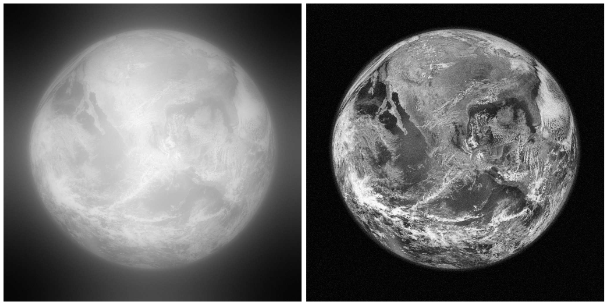
mage of a simulated Earth, at 1024×1024 pixel resolution, at the distance of Proxima Centauri,at 1.3 pc, as projectedby the SGL to an image plane at 650 AU from the Sun. Credit: Toth H. & Turyshev, S.G.
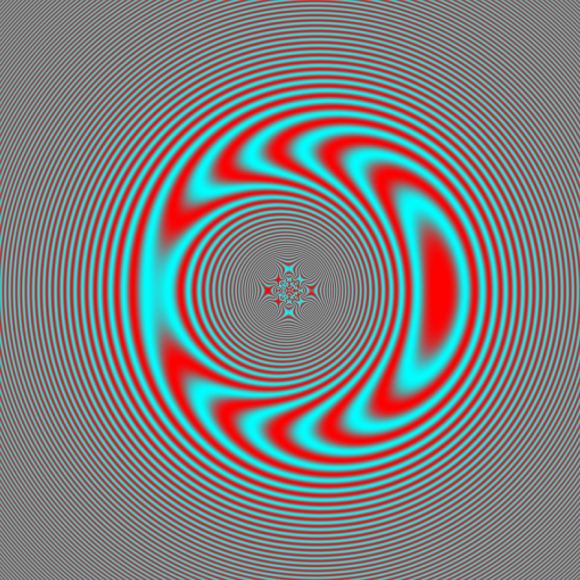
The diffraction effect of a solar lens. Credit: Engeli & Saha
Get a Wonderful Person shirt: More cool designs are on Amazon: Alternatively, PayPal donations can be sent here: Hello and welcome! My name is Anton and in this video, we will talk about a bizarre optical signal discovered by a SETI researcher Links: Unexplained starlight pulses found in optical SETI searches DEEP IN Directed Energy Propulsion for Interstellar Exploration #seti #aliens #signal 0:00 Intro to new SETI research 0:40 Who is Richard Stanton? 1:08 What this study is about and why optical communication works so well 2:20 Why they are so hard to detect 3:20 Discovery of strange optical signals 3:55 Instruments used 4:30 Strange detections from several stars 5:40 Comparison to known signals 6:35 Possible explanations 7:50 It's coming from the solar system 8:25 Opaque ring? 9:00 Conclusions 9:30 More possible explanations Support this channel on Patreon to help me make this a full time job: Space Engine is available for free here: Enjoy and please subscribe. Twitter: Facebook: Twitch: he hardware used to record these videos: CPU: Video Card: Motherboard: RAM: PSU: Case: Microphone: Mixer: Recording and Editing: Some of the above are affiliate links, meaning I would get a (very small) percentage of the price paid. Thank you to all Patreon supporters of this channel Special thanks also goes to all the wonderful supporters of the channel through YouTube Memberships: Credit: StellarResearcher CC BY 4.0
.jpg)
LIGO • Journey of a Gravitational Wave
Fropm Wikipedia pegasi 51
Licenses used: Licenses by 4.0 Licenses by-sa 4.0 Licenses by 3.0 Licenses by-sa 3.0 Licenses by 2.5 Licenses by-sa 2.5 Licenses by 2.0 Licenses by-sa 2.0

range pulses in the light of HD89389 on May 14, 2023. Credit: Stanton, R. H. (2025)
Imagine getting to Mars in just 3 days… or putting points beyond our solar system within our reach. New propulsion technologies could one day take us to these cosmic destinations making space travel truly interstellar! NASA 360 joins Professor Philip Lubin, University of California Santa Barbara, as he discusses his NASA Innovative Advanced Concept (NIAC) for energy propulsion for interstellar exploration. To view "A Roadmap to Interstellar Flight" (cited in the video) visit: This video was developed from a live recording at the 2015 NIAC Fall Symposium in October, 2015. To watch the full original talk please visit: This video represents a research study within the NASA Innovative Advanced Concepts (NIAC) program. NIAC is a visionary and far-reaching aerospace program, one that has the potential to create breakthrough technologies for possible future space missions. However, such early stage technology development may never become actual NASA missions. For more information about NIAC, visit:

Frank Drake

DEEP LASER SAIL Credit UC Santa Barbara
P>
>
P>
Information on Predator-Prey Behaviour in Self-Replicating Interstellar Probes Duncan H. Forgan1 (PDF)
Let’s assume that extra-terrestrial civilizations exist in our galaxy. Like us, they are conducting their own SETI research to find us, see us and study us. What would they see? What methods could they use to learn about us? What technologies have they invented to see and listen to us. And finally, what information will they get from our civilization. Join us for a thought-provoking discussion on the possibility of extraterrestrial civilizations observing our own planet. Our panel of experts, Seth Shostak Senior researcher at the SETI Institute and Paul Dalba, research scientist at the SETI Institute and 51 Pegasi b Fellow of the Heising-Simons Foundation, will present the latest research and theories on this fascinating topic. Don’t miss this opportunity to expand your knowledge and engage in scientific discourse. Molly Bentley, Executive Producer and co-host at Big Picture Science moderates this conversation. If you like science, support the SETI Institute! We're a non-profit research institution whose focus is understanding the nature and origins of life in the universe. Donate here: to the seti institute Learn more about the SETI Institute and stay up-to-date on awesome science: - Subscribe to our YouTube channel at - Watch our streams over on Twitch at - Listen to our podcast, Big Picture Science - Subscribe to our newsletter - Buy merchandise from Chop Shop Don't forget to like and subscribe! Ring the bell for notifications of when we go live. #SETITalks #megastructure #exoplanet #setitalks #seti #arewealone #searchforlife #astrobiology #science #space #astronomy
Oumuamua was an elongated space object, which was discovered speeding past the sun in 2017. At that time is was the only celestial body known to have visited our solar system from another. If you like this interview, check out the more recent ones at this channel or the Saint Helena Forum website at
What would happen if we received a message from an extraterrestrial civilization? Daniela de Paulis, Artist in Residence at the SETI Institute and the Green Bank Observatory (GBO), brought a team of international experts together, including SETI researchers, space scientists, and artists, to stage her latest project, A Sign in Space. On May 24, 2023, the European Space Agency’s ExoMars Trace Gas Orbiter (TGO), in orbit around Mars, will transmit an encoded message to Earth to simulate receiving a signal from extraterrestrial intelligence. Please join us for a live stream hosted by the SETI Institute’s Dr. Franck Marchis and GBO’s Victoria Catlett as they receive the message and learn about the project from various artists and scientists involved. : A Sign in Space website : Join the Discord : Download the data at Filecoin :or on BTL (index of this directory) If you like science, support the SETI Institute! We're a non-profit research institution whose focus is understanding the nature and origins of life in the universe.Donate here: to the seti institute Learn more about the SETI Institute and stay up-to-date on awesome science: - Subscribe to our YouTube channel at - Watch our streams over on Twitch at - Listen to our podcast, Big Picture Science - Subscribe to our newsletter - Buy merchandise from Chop Shop Don't forget to like and subscribe! Ring the bell for notifications of when we go live. #SETITalks #megastructure #exoplanet #seti #firstcontact #sciart #artistinresidence #asigninspace
#insanecuriosity #lifeontitan #titanmoon Titan, the tenth-largest object in the solar system, is a world of mind-boggling extremes, where methane rainstorms drench the landscape and seas of liquid hydrocarbons stretch as far as the eye can see. This giant satellite of the gas giant Saturn has captivated the human imagination for centuries, but its dense atmosphere has long concealed it from close-up exploration. In a surprising twist, recent robotic missions have finally allowed scientists to peer through the veil and uncover detailed imagery of Titan's otherworldly surface. Most notably, the Cassini-Huygens mission has provided an unprecedented glimpse into this distant world. The results have been absolutely stunning, portraying a landscape that appears both alien and yet terrifyingly similar to our own Earth in certain ways. And now, peering through the haze, scientists are discovering several life-sustaining materials pointing to the existence of other life forms on this frozen hydrocarbon landscape. What exactly was discovered on this bizarre moon and are we on the verge of discovering aliens? Join us as we explore the shocking discoveries on Titan that make it a prime candidate for harboring extraterrestrial lifeforms. -- DISCUSSIONS & SOCIAL MEDIA E-mail:Commercial Purposes: Tik Tok: Reddit: Instagram: Twitter: Facebook: Linkedin: Our Website: -- Credits: Ron Miller, Mark A. Garlick / MarkGarlick.com ,Elon Musk/SpaceX/ Flickr -- 00:00 Intro 1:30 Titan analysis 4:40 potential alien life on Titan 7:40 water On Titan 14:30 Titan future missions - Dragonfly Mission end screen why titan not mars -- #insanecuriosity #lifeontitan #titanmoon